 At an event at the London Palladium on 6 December staged to protest against elements in the recent Budget, the Conservative leader, Kemi Badenoch, was asked whether she would introduce a flat-rate income tax if the Conservatives were returned to government. She replied that it was a very attractive idea. But first the economy would need ‘rewiring’ so that the tax burden could be lightened.
At an event at the London Palladium on 6 December staged to protest against elements in the recent Budget, the Conservative leader, Kemi Badenoch, was asked whether she would introduce a flat-rate income tax if the Conservatives were returned to government. She replied that it was a very attractive idea. But first the economy would need ‘rewiring’ so that the tax burden could be lightened.
A flat-rate income tax system could take various forms, but the main feature is that there is a single rate of income tax. The specific rate would depend on how much the government wanted to raise. Also it could apply to just income tax, or to both income tax and social insurance (national insurance contributions (NICs) in the UK), or to income tax, social insurance and the withdrawal rate of social benefits. It could also apply to local/state taxes as well as national/federal taxes.
Take the simplest case of a flat-rate income tax with no personal allowance. In this system the marginal and average rate of tax is the same for everyone. This is known as a proportional tax.
Most countries have a progressive income tax system. This normally involves personal allowances (i.e. a zero rate up to a certain level of income) and then various tax bands, with the marginal rate rising when particular tax thresholds are reached. In England, Wales and Northern Ireland, there are three tax bands: 20%, 40% and 45%. Thus the higher a person’s income is, the higher their average rate of tax.
A regressive tax, by contrast, would be one where the average rate of tax fell as incomes rose. The extreme case of a regressive tax would be a lump-sum tax (such as a TV or other licence), which would be same absolute amount for everyone liable to it, irrespective of their income. This was the case with the ‘poll tax’ (or Community Charge, to give it its official title), introduced by Margaret Thatcher’s government in 1989 in Scotland and 1990 in the rest of the UK. It was a local tax, with each taxpayer taxed the same fixed sum, with the precise amount being set by each local authority. After protests and riots, it was replaced in 1993 by the current system of local taxation (Council Tax) based on property values in bands.
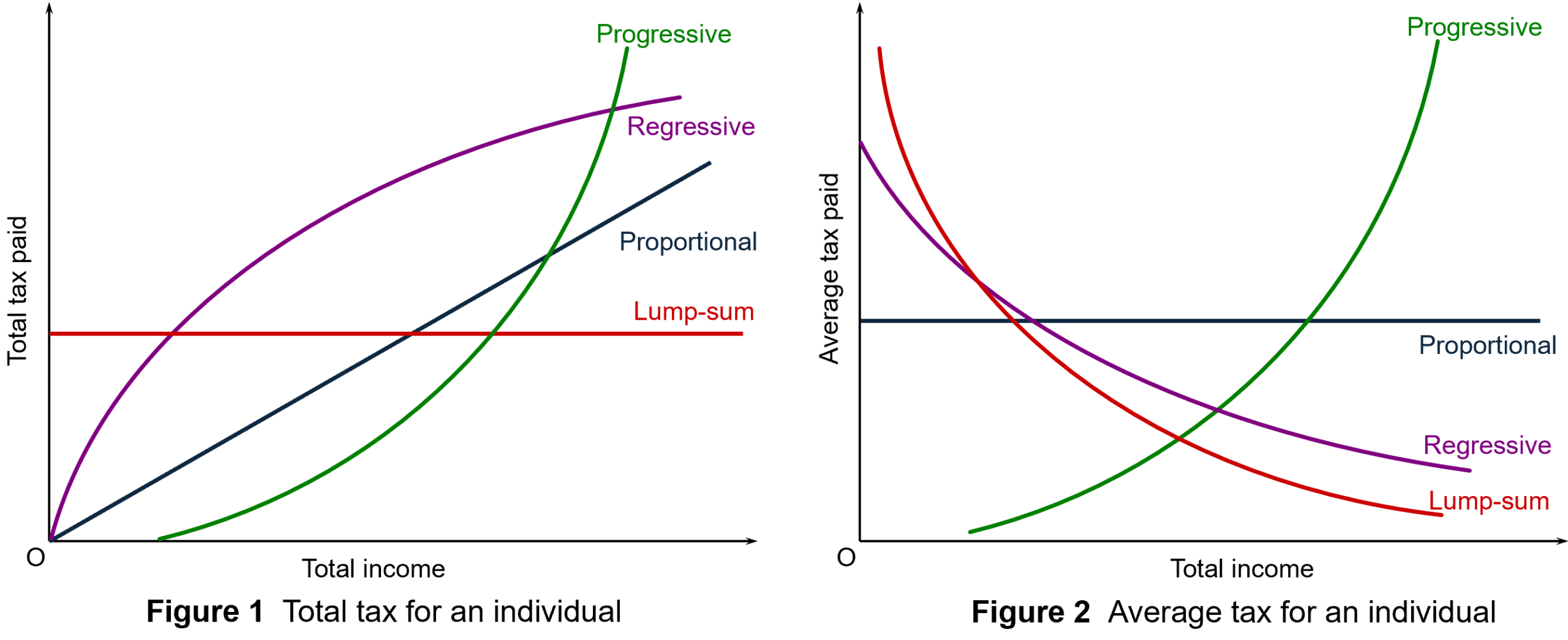
Figures 1 and 2 illustrate these different categories of tax: see Figure 11.12 in Economics, 12th edition. (Click here for a PowerPoint.) Income taxes in most countries are progressive, although just how progressive depends on the differences between the tax bands and the size of personal tax-free allowances. A flat-rate income tax with no allowances is shown by the black line in each diagram, the slope in Figure 1 and the height in Figure 2 depending on the tax rate.
Arguments for a flat-rate income tax
Generally, arguments in favour of flat-rate taxes come from the political right. The two main arguments in favour are tax simplification and incentives.
Advocates argue that a flat tax system makes tax collection easier and makes tax evasion harder. If there are no exemptions, then it can be easier to check that people are paying their taxes and working out the correct amount they owe. It is argued that, in contrast, high tax rates on top earners can encourage tax evasion.
Flat taxes can also be part of a drive to reduce the size of the informal economy. As the VoxEU article states:
Unlike progressive taxes, which include complex and numerous exceptions left to the tax collectors’ discretion, the flat tax is clear cut. In combination with the low rate, its simplicity considerably reduces the stimuli for being informal.
Several post-communist countries in Eastern Europe adopted flat taxes, but for most they were seen as a temporary measure to reduce the informal sector and clamp down on tax evasion. Most have now adopted progressive taxes, with the exceptions of Bulgaria and until recently Russia.
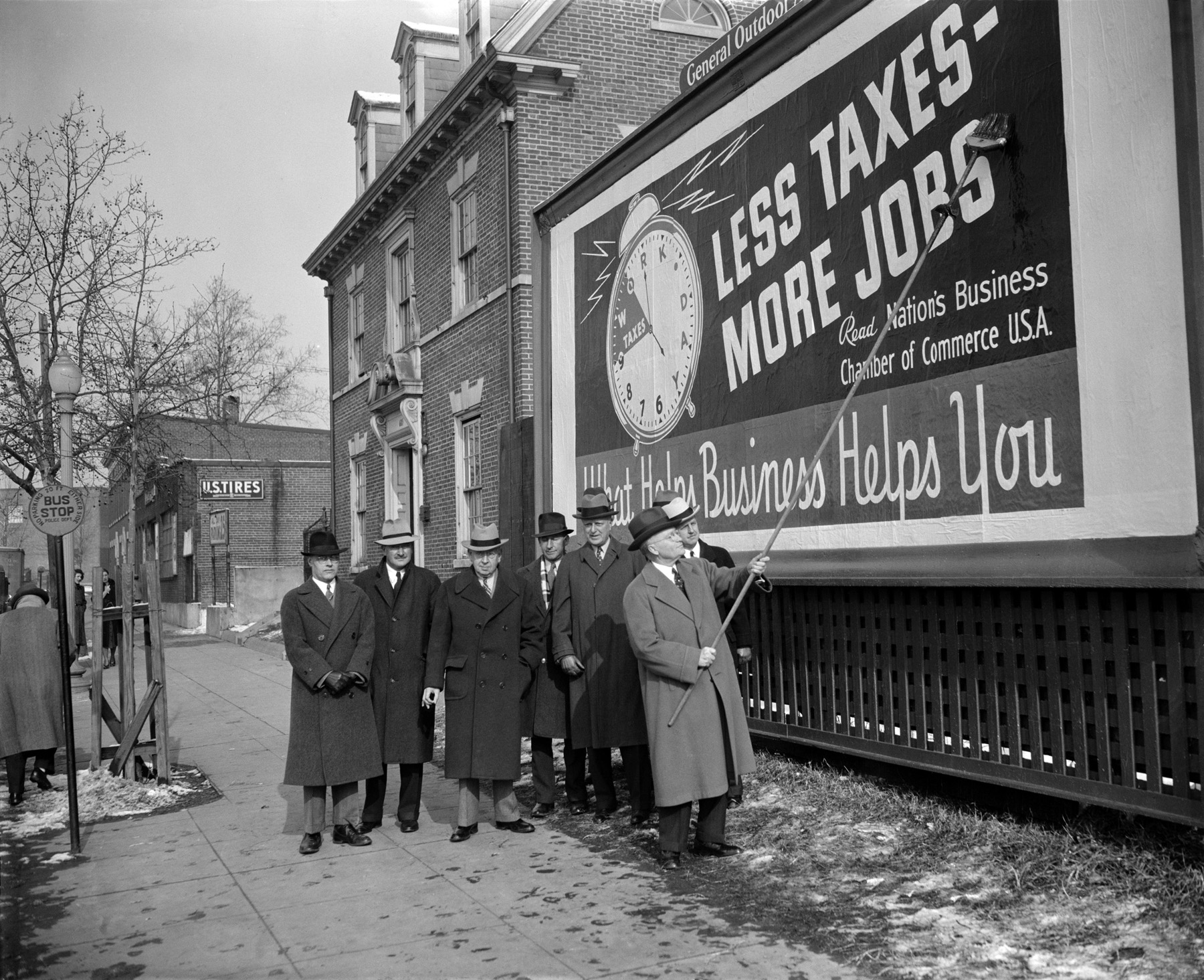 The second major argument is that lower taxes for higher earners, especially for entrepreneurs, can act as a positive incentive. People work harder and there is more investment. The argument here is that the positive substitution effect from the lower tax (work is more profitable now and hence people substitute work for leisure) is greater than the negative income effect (lower taxes increase take-home pay so that people do not need to work so much now to maintain their standard of living).
The second major argument is that lower taxes for higher earners, especially for entrepreneurs, can act as a positive incentive. People work harder and there is more investment. The argument here is that the positive substitution effect from the lower tax (work is more profitable now and hence people substitute work for leisure) is greater than the negative income effect (lower taxes increase take-home pay so that people do not need to work so much now to maintain their standard of living).
Then there is the question of tax evasion. With high rates of income tax for top earners, such people may employ accountants to exploit tax loopholes and hide earnings. This could be seen as highly unfair by middle-income earners who are still paying relatively high rates of tax. Even though a move to flat taxes is likely to mean a cut in tax rates for high earners, the tax take from them could be higher. There is evidence that post-communist and developing countries that have adopted flat taxes have found an increase in tax revenues as evasion is harder.
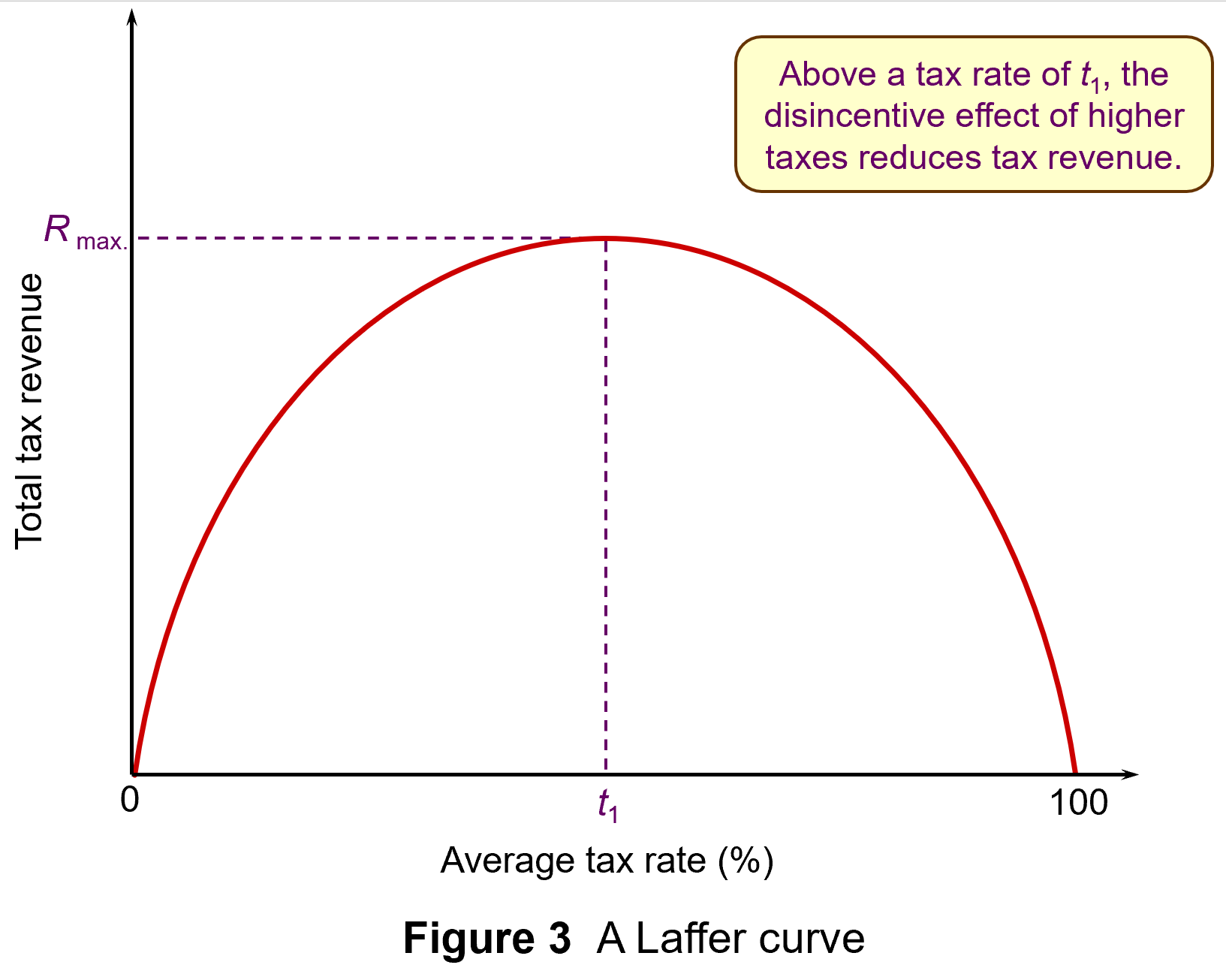 The Laffer curve is often used to illustrate such arguments that high top tax rates can lead to lower tax revenue. Professor Art Laffer was one of President Reagan’s advisers during his first administration (1981–4): see Box 11.3 in Economics, 11th edition. Laffer was a strong advocate of income tax cuts, arguing that substantial increases in output would result and that tax revenues could consequently increase.
The Laffer curve is often used to illustrate such arguments that high top tax rates can lead to lower tax revenue. Professor Art Laffer was one of President Reagan’s advisers during his first administration (1981–4): see Box 11.3 in Economics, 11th edition. Laffer was a strong advocate of income tax cuts, arguing that substantial increases in output would result and that tax revenues could consequently increase.
The Laffer curve in Figure 3 shows tax revenues increasing as the tax rate increases – but only up to a certain tax rate (t1). Thereafter, tax rates become so high that the resulting fall in output more than offsets the rise in tax rate. When the tax rate reaches 100 per cent, the revenue will once more fall to zero, since no one will bother to work. (Click here for a PowerPoint)
However, as Box 11.3 explains, evidence suggests that tax rates in most countries were well below t1 in the 1980s and certainly are now, given the cuts in income tax rates that have been made around the world over the past 20 years.
Arguments against flat-rate income taxes
 The main argument against moving from a progressive to a flat-rate income tax in an advanced country, such as the UK, is that is would involve a large-scale redistribution of income from the poor to the rich. If the tax were designed to raise the same amount of revenue as at present, those on low incomes would pay more tax than now, as their tax rate would rise to the new flat rate. Those on high incomes would pay less tax, as their marginal rate would fall to the new flat rate.
The main argument against moving from a progressive to a flat-rate income tax in an advanced country, such as the UK, is that is would involve a large-scale redistribution of income from the poor to the rich. If the tax were designed to raise the same amount of revenue as at present, those on low incomes would pay more tax than now, as their tax rate would rise to the new flat rate. Those on high incomes would pay less tax, as their marginal rate would fall to the new flat rate.
If a new flat-rate tax in the UK also replaced national insurance contributions (NICs), then the effect would be less extreme as NICs are currently initially progressive, as there is a personal allowance before the 8% rate is applied (on incomes above £12 570 in 2024/25). But above a higher NI threshold (£50 270 in 2024/25), the marginal rate drops to 2%, making it a regressive tax beyond that level. Figure 4 shows tax and NI rates in England, Wales and Northern Ireland for 2024/25. (Click here for a PowerPoint.)
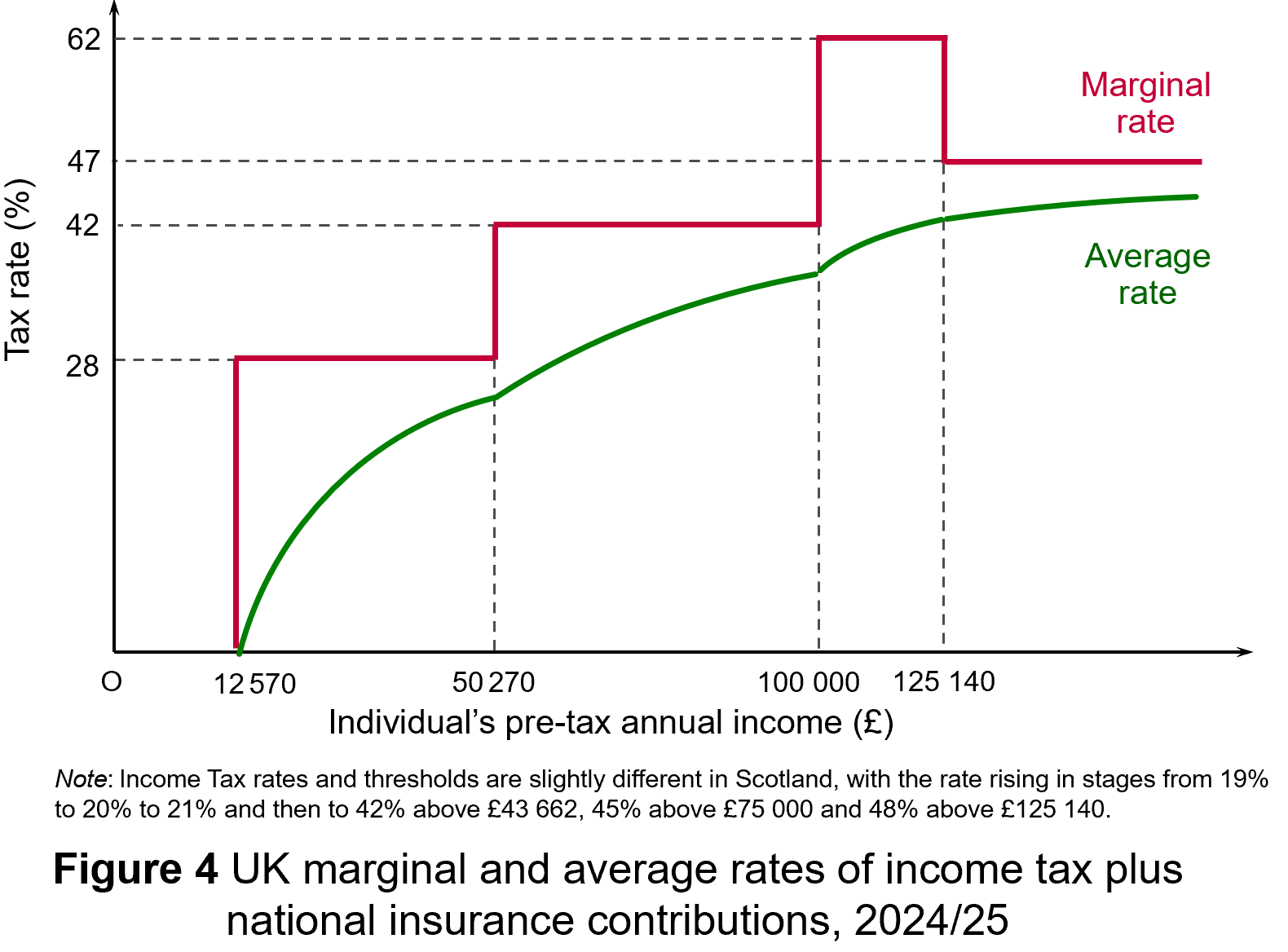 Nevertheless, even if a new flat-rate tax replaced NICs as well as varying rates of income tax, it would still involve a large-scale redistribution from low-income earners to high-income earners. The effect would be mitigated somewhat if personal allowances were raised so that the tax only applied to mid-to-higher incomes. Then the redistribution would be from middle-income earners to high-income earners and also somewhat to low-income earners: i.e. those below, or only a little above, the new higher personal allowance. If, on the other hand, personal allowances were scrapped so that the flat tax applied to all incomes, then there would be a massive redistribution from people on low incomes, including very low incomes, to those on high incomes.
Nevertheless, even if a new flat-rate tax replaced NICs as well as varying rates of income tax, it would still involve a large-scale redistribution from low-income earners to high-income earners. The effect would be mitigated somewhat if personal allowances were raised so that the tax only applied to mid-to-higher incomes. Then the redistribution would be from middle-income earners to high-income earners and also somewhat to low-income earners: i.e. those below, or only a little above, the new higher personal allowance. If, on the other hand, personal allowances were scrapped so that the flat tax applied to all incomes, then there would be a massive redistribution from people on low incomes, including very low incomes, to those on high incomes.
 One of the arguments used to justify a flat-rate tax is that its simplicity would ensure greater compliance. But in an advanced country, compliance is high, except, perhaps, for those on very high incomes. Most people in the UK and many other countries, have tax deducted automatically from their wages. People cannot avoid such taxes.
One of the arguments used to justify a flat-rate tax is that its simplicity would ensure greater compliance. But in an advanced country, compliance is high, except, perhaps, for those on very high incomes. Most people in the UK and many other countries, have tax deducted automatically from their wages. People cannot avoid such taxes.
As far as the self-employed are concerned, they file tax returns online and the software automatically works out the tax due. There are no complex calculations that have to be performed by the individual. There is come scope for tax evasion by charging various expenditures to the business that are really personal spending, but the tax authorities can ask for evidence and sometimes do, with penalties for false claims.
What tax evasion does take place, could still do so with a flat tax. At a rate of, say, 20%, it would still be financially beneficial for a dishonest person to lie if they could get way with it.
Conclusions
If the government did try to introduce a flat-rate income tax, there would probably be an outcry. Also, as some rich people would gain a very large amount of money, the number of people gaining would be lower than the number losing if the total revenue raised were to remain the same. In other words, it would be politically difficult to achieve if the number of losers exceeded the number of gainers.
It is true that if the top rate of income tax were very high, then reducing it might bring in more revenue. But at 45%, or 47% if you include NICs, the top marginal rate in the UK is relatively low compared with other countries. In 2024, the UK had the second lowest top rate of tax out of Western European countries (behind Norway and Switzerland) and only the 16th highest out of 33 European countries when Central and Eastern European countries are also included (see the final ink below under ‘Information’). Reducing the UK’s top rate would be unlikely to bring in more revenue and would redistribute income to high-income earners.
Articles
- Flat tax rate is an ‘attractive idea’, Kemi Badenoch says
The Guardian, Helena Horton (16/12/24)
- Tories could move to a system of ‘flat taxes’ where everyone pays the same rate, Kemi Badenoch indicates
Mail Online, Jason Groves (16/12/24)
- Flat Tax: What It Is and How It Works
Investopedia (8/11/24)
- Flat tax reform in Ukraine: Lessons from Bulgaria
VoxEU, Simeon Djankov (11/12/22)
- Why not… introduce a flat tax?
BBC News, Brian Wheeler (3/7/13)
- Five country cases illustrate how best to improve tax collection
IMF Finance and Development Magazine, Bernardin Akitoby (March 2018)
- Flat taxes and the desire to increase inequality
Funding the Future blog, Richard Murphy (15/5/14)
- Options for a UK ‘flat tax’: some simple simulations
IFS Briefing Note, Stuart Adam and James Browne (August 2006)
- Are the Flat Tax Folks Winning — or Have They Already Won?
Inequality.org, Sam Pizzigati (20/4/24)
Information
Questions
- Distinguish between progressive, proportional, regressive and lump-sum taxes. Into which of these four categories would you place (a) VAT, (b) motor fuel duties, (c) tobacco duties, (d) road-fund licence, (e) inheritance tax? Where the answer is either progressive or regressive, how progressive or regressive are they?
- What are the income and substitution effects of changing tax rates?
- Explain the Laffer curve and consider whether it is likely to be symmetrical.
- Discuss the desirability of having a flat tax set at a relatively high rate (say 25%) with tax-free personal allowances up to the level of income considered to be the poverty threshold. (In the UK the poverty threshold is often defined as 60% of median income.)
- In the London Palladium event where Kemi Badenoch stated that flat taxes were a very attractive idea, she also said that ‘We cannot afford flat taxes where we are now. We need to make sure we rewire our economy so that we can lighten the burden of tax and the regulation on individuals and on those businesses that are just starting out, in particular’. What do you think she meant by this?
- Find out what Bulgaria’s experience of a flat tax of 10% has been.
 On March 23, Rishi Sunak, the UK’s Chancellor of the Exchequer, delivered his Spring Statement, in which he announced changes to various taxes and grants. These measures were made against the background of rising inflation and falling living standards.
On March 23, Rishi Sunak, the UK’s Chancellor of the Exchequer, delivered his Spring Statement, in which he announced changes to various taxes and grants. These measures were made against the background of rising inflation and falling living standards.
CPI inflation, currently at 6.2%, is still rising and the Office for Budget Responsibility forecasts that inflation will average 7.4% this year. The poor spend a larger proportion of their income on energy and food than the rich. With inflation rates especially high for gas, electricity and basic foodstuffs, the poor have been seen their cost of living rise by considerably more than the overall inflation rate.
According to the OBR, the higher inflation, by reducing real income and consumption, is expected to reduce the growth in real GDP this year from the previously forecast 6% to 3.8% – a much smaller bounce back from the fall in output during the early stages of the pandemic. Despite this growth in GDP, real disposable incomes will fall by an average of £488 per person this year. As the OBR states:
With inflation outpacing growth in nominal earnings and net taxes due to rise in April, real living standards are set to fall by 2.2 per cent in 2022/23 – their largest financial year fall on record – and not recover their pre-pandemic level until 2024/25.
Fiscal measures
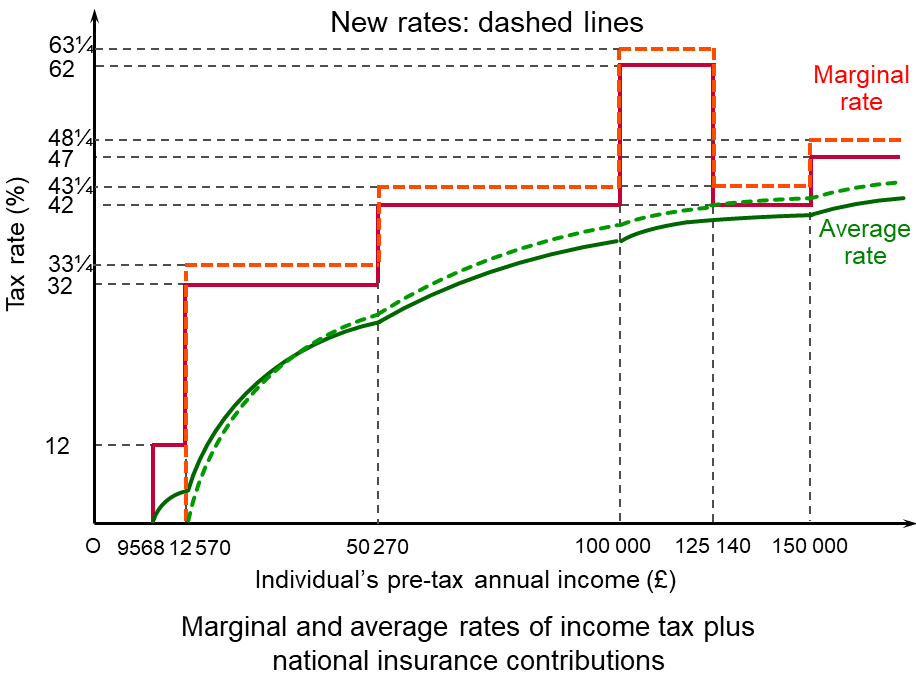 The Chancellor announced a number of measures, which, he argued, would provide relief from rises in the cost of living.
The Chancellor announced a number of measures, which, he argued, would provide relief from rises in the cost of living.
- Previously, the Chancellor had announced that national insurance (NI) would rise by 1.25 percentage points this April. In the Statement he announced that the starting point for paying NI would rise from a previously planned £9880 to £12 570 (the same as the starting point for income tax). This will more than offset the rise in the NI rate for those earning below £32 000. This makes the NI system slightly more progressive than before. (Click here for a PowerPoint of the chart.)
- A cut in fuel duty of 5p per litre. The main beneficiaries will be those who drive more and those with bigger cars – generally the better off. Those who cannot afford a car will not benefit at all, other than from lower transport costs being passed on in lower prices.
- The 5% VAT on energy-saving household measures such as solar panels, insulation and heat pumps will be reduced to zero.
- The government’s Household Support Fund will be doubled to £1bn. This provides money to local authorities to help vulnerable households with rising living costs.
- Research and development tax credits for businesses will increase and small businesses will each get another £1000 per year in the form of employment allowances, which reduce their NI payments. He announced that taxes on business investment will be further cut in the Autumn Budget.
- The main rate of income tax will be cut from 20% to 19% in two years’ time. Unlike the rise in NI, which only affects employment and self-employment income, the cut in income tax will apply to all incomes, including rental and savings income.
Fiscal drag
 The Chancellor announced that public finances are stronger than previously forecast. The rapid growth in tax receipts has reduced public-sector borrowing from £322 billion (15.0 per cent of GDP) in 2020/21 to an expected £128 billion (5.4 per cent of GDP) in 2021/22, £55 billion less than the OBR forecast in October 2021. This reflects not only the growth in the economy, but also inflation, which results in fiscal drag.
The Chancellor announced that public finances are stronger than previously forecast. The rapid growth in tax receipts has reduced public-sector borrowing from £322 billion (15.0 per cent of GDP) in 2020/21 to an expected £128 billion (5.4 per cent of GDP) in 2021/22, £55 billion less than the OBR forecast in October 2021. This reflects not only the growth in the economy, but also inflation, which results in fiscal drag.
Fiscal drag is where rises in nominal incomes mean that the average rate of income tax rises. As tax thresholds for 2022/23 are frozen at 2021/22 levels, a greater proportion of incomes will be taxed at higher rates and tax-free allowances will account for a smaller proportion of incomes. The higher the rate of increase in nominal incomes, the greater fiscal drag becomes. The higher average rate of tax drags on real incomes and spending. On the other hand, the extra tax revenue reduces government borrowing and gives the government more room for extra spending or tax cuts.
The growth in poverty
 With incomes of the poor not keeping pace with inflation, many people are facing real hardship. While the Spring Statement will provide a small degree of support to the poor through cuts in fuel duty and the rise in the NI threshold, the measures are poorly targeted. Rather than cutting fuel duty by 5p, a move that is regressive, removing or reducing the 5% VAT on gas and electricity would have been a progressive move.
With incomes of the poor not keeping pace with inflation, many people are facing real hardship. While the Spring Statement will provide a small degree of support to the poor through cuts in fuel duty and the rise in the NI threshold, the measures are poorly targeted. Rather than cutting fuel duty by 5p, a move that is regressive, removing or reducing the 5% VAT on gas and electricity would have been a progressive move.
Benefits, such as Universal Credit and the State Pension, are uprated each April in line with inflation the previous September. When inflation is rising, this means that benefits will go up by less than the current rate of inflation. This April, benefits will rise by last September’s annual inflation rate of 3.1% – considerably below the current inflation rate of 6.2% and the forecast rate for this year of 7.4%. This will push many benefit recipients deeper into poverty.
One measure rejected by Rishi Sunak is to impose a temporary windfall tax on oil companies, which have profited from the higher global oil prices. Such taxes are used in Norway and are currently being considered by the EU. Tax revenues from such a windfall tax could be used to fund benefit increases or tax reductions elsewhere and these measures could be targeted on the poor.
Articles
- Overview of the March 2022 Economic and fiscal outlook
Office for Budget Responsibility (23/3/22)
- Spring Statement: Key points at a glance
BBC News (23/3/22)
- Spring statement 2022: key points at a glance
The Guardian, Richard Partington and Jessica Elgot (23/3/22)
- People face biggest drop in living standards since 1956
BBC News (23/3/22)
- Spring Statement: Rishi Sunak accused of not doing enough for poorest households
BBC News (24/3/22)
- Chancellor provides minimal help to households on cost of living crisis
Financial Times, Chris Giles (23/3/22)
- Britain’s poorest left to bear brunt of squeeze on cost of living
Financial Times, Delphine Strauss (23/3/22)
- Spring statement: How does Rishi Sunak’s national insurance change affect you?
Sky News, Daniel Dunford and Ganesh Rao (24/3/22)
- Spring Statement 2022 – An initial response from IFS researchers
Institute for Fiscal Studies Press Release, Stuart Adam, Carl Emmerson, Paul Johnson, Helen Miller, Isabel Stockton, Tom Waters and Ben Zaranko (23/3/22)
- Chancellor prioritises his tax cutting credentials over low-and-middle income households with £2 in every £3 of new support going to the top half
Resolution Foundation press release (23/3/22)
- Richest handed £480 boost in Spring Statement, say researchers
Politics.co.uk (23/3/22)
- UK’s most vulnerable face crunch as Rishi Sunak helps better-off
The Guardian, Larry Elliott and Heather Stewart (23/3/22)
- Rishi Sunak tackled over failure to help poorest families
The Guardian, Richard Partington and Aubrey Allegretti (24/3/22)
- A Spring Statement for White Wealth Drivers
Byline Times, Stan Norris (23/3/22)
- Rishi Sunak’s Fiscal Drag Race
Evening Standard, Jack Kessler (23/3/22)
- Rishi Sunak fails to address the hit to living standards
Financial Times, Martin Wolf (23/3/22)
- Why Rishi Sunak refused a windfall tax on oil and gas companies
The New Statesman, Philippa Nuttall (23/3/22)
OBR data and analysis
Questions
- Are the changes made to national insurance by the Chancellor progressive or regressive? Could they have been made more progressive and, if so, how?
- What are the arguments for and against cutting income tax from 20% to 19% in two years’ time rather than reversing the current increases in national insurance at that point?
- What will determine how rapidly (if at all) public-sector borrowing decreases over the next few years?
- What are automatic fiscal stabilisers? How does their effect vary with the rate of inflation?
- Examine the public finances of another country. Are the issues similar to those in the UK? Recommend fiscal policy measures for your chosen country and provide a justification.

The first article below, from The Economist, examines likely macroeconomic policy under Donald Trump. He has stated that he plans to cut taxes, including reducing the top rates of income tax and reducing taxes on corporate income and capital gains. At the same time he has pledged to increase infrastructure spending.
This expansionary fiscal policy is unlikely to be accompanied by accommodating monetary policy. Interest rates would therefore rise to tackle the inflationary pressures from the fiscal policy. One effect of this would be to drive up the dollar and therein lies significant risks.
The first is that the value of dollar-denominated debt would rise in foreign currency terms, thereby making it difficult for countries with high levels of dollar debt to service those debts, possibly leading to default and resulting international instability. At the same time, a rising dollar may encourage capital 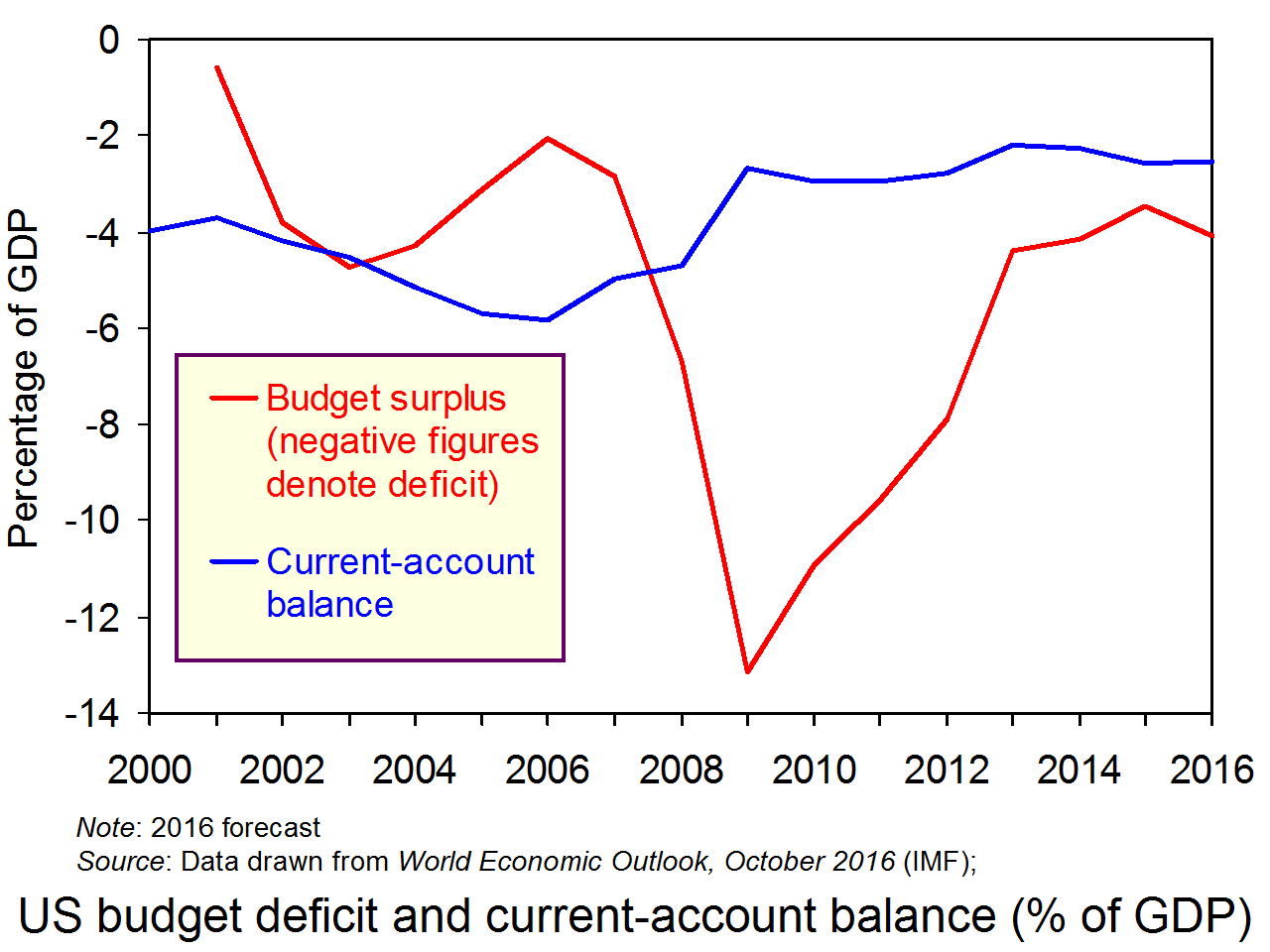 flight from weaker countries to the US (see The Economist article, ‘Emerging markets: Reversal of fortune’).
flight from weaker countries to the US (see The Economist article, ‘Emerging markets: Reversal of fortune’).
The second risk is that a rising dollar would worsen the US balance of trade account as US exports became less competitive and imports became more so. This may encourage Donald Trump to impose tariffs on various imports – something alluded to in campaign speeches. But, as we saw in the blog, Trump and Trade, “With complex modern supply chains, many products use components and services, such as design and logistics, from many different countries. Imposing restrictions on imports may lead to damage to products which are seen as US products”.
The third risk is that the main beneficiaries of Trump’s likely fiscal measures will be the rich, who would end up paying significantly less tax. With all the concerns from poor Americans, including people who voted for Trump, about growing inequality, measures that increase this inequality are unlikely to prove popular.
Articles
That Eighties show The Economist, Free Exchange (19/11/16)
The unbearable lightness of a stronger dollar Financial Times (18/11/16)
Questions
- What should the Fed’s response be to an expansionary fiscal policy?
- Which is likely to have the larger multiplier effect: (a) tax revenue reductions from cuts in the top rates of income; (b) increased government spending on infrastructure projects? Explain your answer.
- Could Donald Trump’s proposed fiscal policy lead to crowding out? Explain.
- What would protectionist policies do to (a) the US current account and (b) dollar exchange rates?
- Why might trying to protect US industries from imports prove difficult?
- Why might Trump’s proposed fiscal policy lead to capital flight from certain developing countries? Which types of country are most likely to lose from this process?
- Go though each of the three risks referred to in The Economist article and identify things that the US administration could do to mitigate these risks.
- Why may the rise in the US currency since the election be reversed?
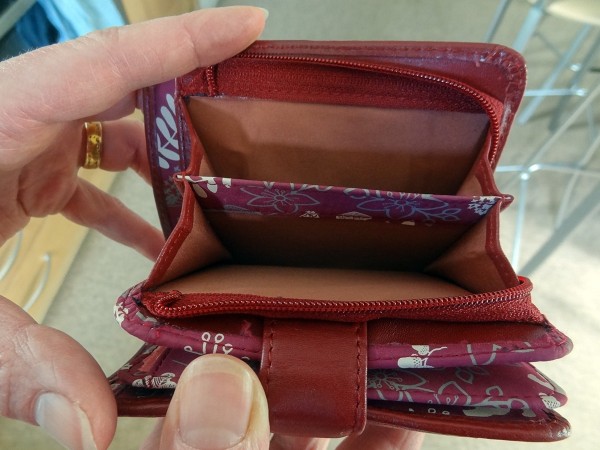 What is the relationship between the degree of inequality in a country and the rate of economic growth? The traditional answer is that there is a trade off between the two. Increasing the rewards to those who are more productive or who invest encourages a growth in productivity and capital investment, which, in turn, leads to faster economic growth. Redistribution from the rich to the poor, by contrast, is argued to reduce incentives by reducing the rewards from harder work, education, training and investment. Risk taking, it is claimed, is discouraged.
What is the relationship between the degree of inequality in a country and the rate of economic growth? The traditional answer is that there is a trade off between the two. Increasing the rewards to those who are more productive or who invest encourages a growth in productivity and capital investment, which, in turn, leads to faster economic growth. Redistribution from the rich to the poor, by contrast, is argued to reduce incentives by reducing the rewards from harder work, education, training and investment. Risk taking, it is claimed, is discouraged.
Recent evidence from the OECD and the IMF, however, suggests that when income inequality rises, economic growth falls. Inequality has grown massively in many countries, with average incomes at the top of the distribution seeing particular gains, while many at the bottom have experienced actual declines in real incomes or, at best, little or no growth.  This growth in inequality can be seen in a rise in countries’ Gini coefficients. The OECD average Gini coefficient rose from 0.29 in the mid-1980s to 0.32 in 2011/12. This, claims the OECD, has led to a loss in economic growth of around 0.35 percentage points per year.
This growth in inequality can be seen in a rise in countries’ Gini coefficients. The OECD average Gini coefficient rose from 0.29 in the mid-1980s to 0.32 in 2011/12. This, claims the OECD, has led to a loss in economic growth of around 0.35 percentage points per year.
But why should a rise in inequality lead to lower economic growth? According to the OECD, the main reason is that inequality reduces the development of skills of the lower income groups and reduces social mobility.
By hindering human capital accumulation, income inequality undermines education opportunities for disadvantaged individuals, lowering social mobility and hampering skills development.
The lower educational attainment applies both to the length and quality of education: people from poorer backgrounds on average leave school or college earlier and with lower qualifications.
But if greater inequality generally results in lower economic growth, will a redistribution from rich to poor necessarily result in faster economic growth? According to the OECD:
Anti-poverty programmes will not be enough. Not only cash transfers but also increasing access to public services, such as high-quality education, training and healthcare, constitute long-term social investment to create greater equality of opportunities in the long run.
Thus redistribution policies need to be well designed and implemented and focus on raising incomes of the poor through increased opportunities to increase their productivity. Simple transfers from rich to poor via the tax and benefits system may, in fact, undermine economic growth. According to the IMF:
That equality seems to drive higher and more sustainable growth does not in itself support efforts to redistribute. In particular, inequality may impede growth at least in part because it calls forth efforts to redistribute that themselves undercut growth. In such a situation, even if inequality is bad for growth, taxes and transfers may be precisely the wrong remedy.
Articles
Inequality ‘significantly’ curbs economic growth – OECD BBC News (9/12/14)
Is inequality the enemy of growth? BBC News, Robert Peston (6/10/14)
Income inequality damages growth, OECD warns Financial Times, Chris Giles (8/10/14)
OECD finds increasing inequality lowers growth Deutsche Welle, Jasper Sky (10/12/14)
Revealed: how the wealth gap holds back economic growth The Guardian, Larry Elliott (9/12/14)
Inequality Seriously Damages Growth, IMF Seminar Hears IMF Survey Magazine (12/4/14)
Warning! Inequality May Be Hazardous to Your Growth iMFdirect, Andrew G. Berg and Jonathan D. Ostry (8/4/11)
Economic growth more likely when wealth distributed to poor instead of rich The Guardian, Stephen Koukoulas (4/6/15)
So much for trickle down: only bold reforms will tackle inequality The Guardian, Larry Elliott (21/6/15)
Videos
Record inequality between rich and poor OECD on YouTube (5/12/11)
The Price of Inequality The News School on YouTube, Joseph Stiglitz (5/10/12)
Reports and papers
FOCUS on Inequality and Growth OECD, Directorate for Employment, Labour and Social Affairs (December 2014)
Trends in Income Inequality and its Impact on Economic Growth OECD Social, Employment and Migration Working Papers, Federico Cingano (9/12/14)
An Overview of Growing Income Inequalities in OECD Countries: Main Findings OCED (2011)
Redistribution, Inequality, and Growth IMF Staff Discussion Note, Jonathan D. Ostry, Andrew Berg, and Charalambos G. Tsangarides (February 2014)
Measure to Measure Finance and Development, IMF, Jonathan D. Ostry and Andrew G. Berg (Vol. 51, No. 3, September 2014)
Data
OECD Income Distribution Database: Gini, poverty, income, Methods and Concepts OECD
The effects of taxes and benefits on household income ONS
Questions
- Explain what are meant by a Lorenz curve and a Gini coefficient? What is the relationship between the two?
- The Gini coefficient is one way of measuring inequality. What other methods are there? How suitable are they?
- Assume that the government raises taxes to finance higher benefits to the poor. Identify the income and substitution effects of the tax increases and whether the effects are to encourage or discourage work (or investment).
- Distinguish between (a) progressive, (b) regressive and (c) proportional taxes?
- How will the balance of income and substitution effects vary in each of the following cases: (a) a cut in the tax-free allowance; (b) a rise in the basic rate of income tax; (c) a rise in the top rate of income tax? How does the relative size of the two effects depend, in each case, on a person’s current income?
- Identify policy measures that would increase both equality and economic growth.
- Would a shift from direct to indirect taxes tend to increase or decrease inequality? Explain.
- By examining Tables 3, 26 and 27 in The Effects of Taxes and Benefits on Household Income, 2012/13, (a) explain the difference between original income, gross income, disposable income and post-tax income; (b) explain the differences between the Gini coefficients for each of these four categories of income in the UK.
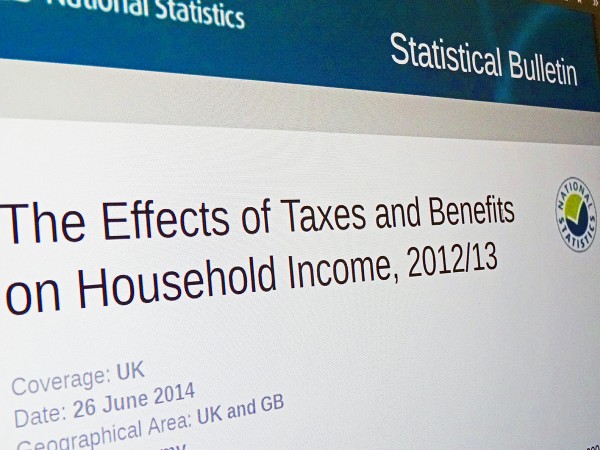 The ONS has just released its annual publication, The Effects of Taxes and Benefits on Household Income. The report gives data for the financial year 2012/13 and historical data from 1977 to 2012/13.
The ONS has just released its annual publication, The Effects of Taxes and Benefits on Household Income. The report gives data for the financial year 2012/13 and historical data from 1977 to 2012/13.
The publication looks at the distribution of income both before and after taxes and benefits. It divides the population into five and ten equal-sized groups by household income (quintiles and deciles) and shows the distribution of income between these groups. It also looks at distribution within specific categories of the population, such as non-retired and retired households and different types of household composition.
The data show that the richest fifth of households had an average pre-tax-and-benefit income of £81,284 in 2012/13, 14.7 times greater than average of £5536 for the poorest fifth. The richest tenth had an average pre-tax-and-benefit income of £104,940, 27.1 times greater than the average of £3875 for the poorest tenth.
 After the receipt of cash benefits, these gaps narrow to 6.6 and 11.0 times respectively. When the effect of direct taxes are included (giving ‘disposable income’), the gaps narrow further to 5.6 and 9.3 times respectively. However, when indirect taxes are also included, the gaps widen again to 6.9 and 13.6 times.
After the receipt of cash benefits, these gaps narrow to 6.6 and 11.0 times respectively. When the effect of direct taxes are included (giving ‘disposable income’), the gaps narrow further to 5.6 and 9.3 times respectively. However, when indirect taxes are also included, the gaps widen again to 6.9 and 13.6 times.
This shows that although direct taxes are progressive between bottom and top quintiles and deciles, indirect taxes are so regressive that the overall effect of taxes is regressive. In fact, the richest fifth paid 35.1% of their income in tax, whereas the poorest fifth paid 37.4%.
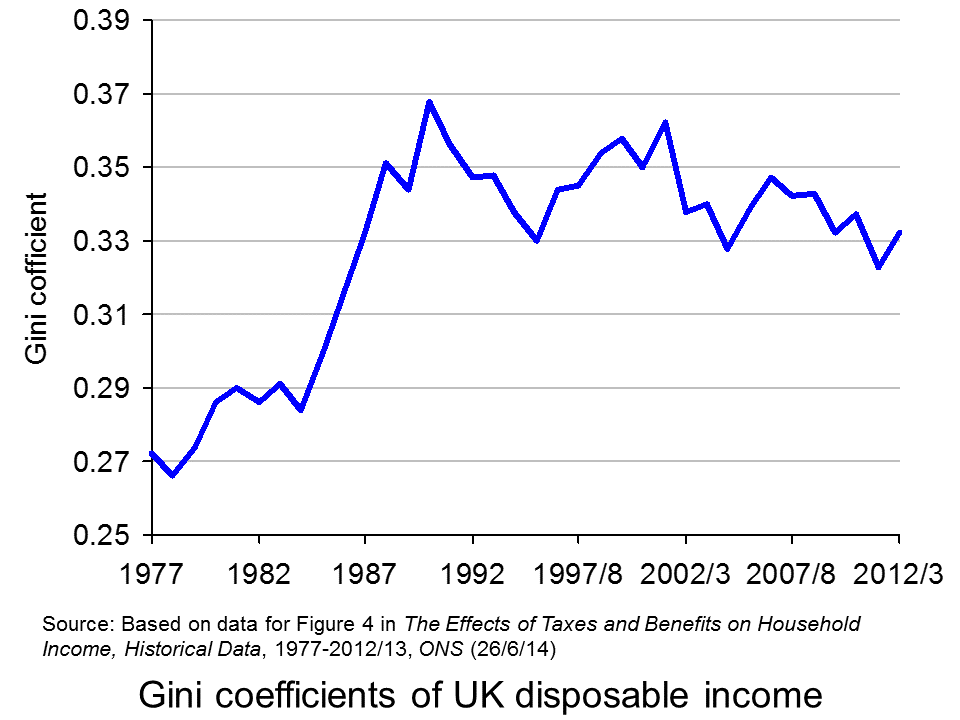 Taking the period from 1977 to 2012/13, inequality of disposable income (i.e. income after direct taxes and cash benefits) increased from 1977 to 1988, especially during the second two Thatcher governments (1983 to 1990) (see chart opposite). But then in the first part of the 1990s inequality fell, only to rise again in the late 1990s and early 2000s. However, with the Labour government giving greater cash benefits for the poor, inequality reduced once more, only to widen again in the boom running up to the banking crisis of 2007/8. But then, with recession taking hold, the incomes of many top earners fell and automatic stabilisers helped protect the incomes of the poor. Inequality consequently fell. But with the capping of benefit increases and a rise in incomes of many top earners as the economy recovers, so inequality is beginning to rise once more – in 2012/13, the Gini coefficient rose to 0.332 from 0.323 the previous year.
Taking the period from 1977 to 2012/13, inequality of disposable income (i.e. income after direct taxes and cash benefits) increased from 1977 to 1988, especially during the second two Thatcher governments (1983 to 1990) (see chart opposite). But then in the first part of the 1990s inequality fell, only to rise again in the late 1990s and early 2000s. However, with the Labour government giving greater cash benefits for the poor, inequality reduced once more, only to widen again in the boom running up to the banking crisis of 2007/8. But then, with recession taking hold, the incomes of many top earners fell and automatic stabilisers helped protect the incomes of the poor. Inequality consequently fell. But with the capping of benefit increases and a rise in incomes of many top earners as the economy recovers, so inequality is beginning to rise once more – in 2012/13, the Gini coefficient rose to 0.332 from 0.323 the previous year.
As far as income after cash benefits and both direct and indirect taxes is concerned, the average income of the richest quintile relative to that of the poorest quintile rose from 7.2 in 2002/3 to 7.6 in 2007/8 and then fell to 6.9 in 2012/13.
Other headlines in the report include:
Since the start of the economic downturn in 2007/08, the average disposable income has decreased for the richest fifth of households but increased for the poorest fifth.
Cash benefits made up over half (56.4%) of the gross income of the poorest fifth of households, compared with 3.2% of the richest fifth, in 2012/13.
The average disposable income in 2012/13 was unchanged from 2011/12, but it remains lower than at the start of the economic downturn, with equivalised disposable income falling by £1200 since 2007/08 in real terms. The fall in income has been largest for the richest fifth of households (5.2%). In contrast, after accounting for inflation and household composition, the average income for the poorest fifth has grown over this period (3.5%).
This is clearly a mixed picture in terms of whether the UK is becoming more or less equal. Politicians will, no doubt, ‘cherry pick’ the data that suit their political position. In general, the government will present a good news story and the opposition a bad news one. As economists, it is hoped that you can take a dispassionate look at the data and attempt to relate the figures to policies and events.
Report
The Effects of Taxes and Benefits on Household Income, 2012/13 ONS (26/6/14)
Data
Reference tables in The Effects of Taxes and Benefits on Household Income, 2012/13 ONS (26/6/14)
The Effects of Taxes and Benefits on Household Income, Historical Data, 1977-2012/13 ONS (26/6/14)
Rates of Income Tax: 1990-91 to 2014-15 HMRC
Articles
Inequality is on the up again – Osborne’s boast is over New Statesman, George Eaton (26/6/14)
Disposable incomes rise for richest fifth households only Money.com, Lucinda Beeman (26/6/14)
Half of families receive more from the state than they pay in taxes but income equality widens as rich get richer Mail Online, Matt Chorley (26/6/14)
Rich getting richer as everyone else is getting poorer, Government’s own figures reveal Mirror, Mark Ellis (26/6/14)
The Richest Households Got Richer Last Year, While Everyone Else Got Poorer The Economic Voice (27/6/14)
Questions
- Define the following terms: original income, gross income, disposable income, post-tax income, final income.
- How does the receipt of benefits in kind vary across the quintile groups? Explain.
- What are meant by the Lorenz curve and the Gini coefficient and how is the Gini coefficient measured? Is it a good way of measuring inequality?
- Paint a picture of how income distribution has changed over the past 35 years.
- Can changes in tax be a means of helping the poorest in society?
- What types of income tax cuts are progressive and what are regressive?
- Why are taxes in the UK regressive?
- Why has the fall in income been largest for the richest fifth of households since 2007/8? Does this mean that, as the economy recovers, the richest fifth of households are likely to experience the fastest increase in disposable incomes?
 At an event at the London Palladium on 6 December staged to protest against elements in the recent Budget, the Conservative leader, Kemi Badenoch, was asked whether she would introduce a flat-rate income tax if the Conservatives were returned to government. She replied that it was a very attractive idea. But first the economy would need ‘rewiring’ so that the tax burden could be lightened.
At an event at the London Palladium on 6 December staged to protest against elements in the recent Budget, the Conservative leader, Kemi Badenoch, was asked whether she would introduce a flat-rate income tax if the Conservatives were returned to government. She replied that it was a very attractive idea. But first the economy would need ‘rewiring’ so that the tax burden could be lightened.
 The second major argument is that lower taxes for higher earners, especially for entrepreneurs, can act as a positive incentive. People work harder and there is more investment. The argument here is that the positive substitution effect from the lower tax (work is more profitable now and hence people substitute work for leisure) is greater than the negative income effect (lower taxes increase take-home pay so that people do not need to work so much now to maintain their standard of living).
The second major argument is that lower taxes for higher earners, especially for entrepreneurs, can act as a positive incentive. People work harder and there is more investment. The argument here is that the positive substitution effect from the lower tax (work is more profitable now and hence people substitute work for leisure) is greater than the negative income effect (lower taxes increase take-home pay so that people do not need to work so much now to maintain their standard of living). The Laffer curve is often used to illustrate such arguments that high top tax rates can lead to lower tax revenue. Professor Art Laffer was one of President Reagan’s advisers during his first administration (1981–4): see Box 11.3 in Economics, 11th edition. Laffer was a strong advocate of income tax cuts, arguing that substantial increases in output would result and that tax revenues could consequently increase.
The Laffer curve is often used to illustrate such arguments that high top tax rates can lead to lower tax revenue. Professor Art Laffer was one of President Reagan’s advisers during his first administration (1981–4): see Box 11.3 in Economics, 11th edition. Laffer was a strong advocate of income tax cuts, arguing that substantial increases in output would result and that tax revenues could consequently increase.  The main argument against moving from a progressive to a flat-rate income tax in an advanced country, such as the UK, is that is would involve a large-scale redistribution of income from the poor to the rich. If the tax were designed to raise the same amount of revenue as at present, those on low incomes would pay more tax than now, as their tax rate would rise to the new flat rate. Those on high incomes would pay less tax, as their marginal rate would fall to the new flat rate.
The main argument against moving from a progressive to a flat-rate income tax in an advanced country, such as the UK, is that is would involve a large-scale redistribution of income from the poor to the rich. If the tax were designed to raise the same amount of revenue as at present, those on low incomes would pay more tax than now, as their tax rate would rise to the new flat rate. Those on high incomes would pay less tax, as their marginal rate would fall to the new flat rate. Nevertheless, even if a new flat-rate tax replaced NICs as well as varying rates of income tax, it would still involve a large-scale redistribution from low-income earners to high-income earners. The effect would be mitigated somewhat if personal allowances were raised so that the tax only applied to mid-to-higher incomes. Then the redistribution would be from middle-income earners to high-income earners and also somewhat to low-income earners: i.e. those below, or only a little above, the new higher personal allowance. If, on the other hand, personal allowances were scrapped so that the flat tax applied to all incomes, then there would be a massive redistribution from people on low incomes, including very low incomes, to those on high incomes.
Nevertheless, even if a new flat-rate tax replaced NICs as well as varying rates of income tax, it would still involve a large-scale redistribution from low-income earners to high-income earners. The effect would be mitigated somewhat if personal allowances were raised so that the tax only applied to mid-to-higher incomes. Then the redistribution would be from middle-income earners to high-income earners and also somewhat to low-income earners: i.e. those below, or only a little above, the new higher personal allowance. If, on the other hand, personal allowances were scrapped so that the flat tax applied to all incomes, then there would be a massive redistribution from people on low incomes, including very low incomes, to those on high incomes. One of the arguments used to justify a flat-rate tax is that its simplicity would ensure greater compliance. But in an advanced country, compliance is high, except, perhaps, for those on very high incomes. Most people in the UK and many other countries, have tax deducted automatically from their wages. People cannot avoid such taxes.
One of the arguments used to justify a flat-rate tax is that its simplicity would ensure greater compliance. But in an advanced country, compliance is high, except, perhaps, for those on very high incomes. Most people in the UK and many other countries, have tax deducted automatically from their wages. People cannot avoid such taxes. On March 23, Rishi Sunak, the UK’s Chancellor of the Exchequer, delivered his Spring Statement, in which he announced changes to various taxes and grants. These measures were made against the background of rising inflation and falling living standards.
On March 23, Rishi Sunak, the UK’s Chancellor of the Exchequer, delivered his Spring Statement, in which he announced changes to various taxes and grants. These measures were made against the background of rising inflation and falling living standards.  The Chancellor announced a number of measures, which, he argued, would provide relief from rises in the cost of living.
The Chancellor announced a number of measures, which, he argued, would provide relief from rises in the cost of living. The Chancellor announced that public finances are stronger than previously forecast. The rapid growth in tax receipts has reduced public-sector borrowing from £322 billion (15.0 per cent of GDP) in 2020/21 to an expected £128 billion (5.4 per cent of GDP) in 2021/22, £55 billion less than the OBR forecast in October 2021. This reflects not only the growth in the economy, but also inflation, which results in fiscal drag.
The Chancellor announced that public finances are stronger than previously forecast. The rapid growth in tax receipts has reduced public-sector borrowing from £322 billion (15.0 per cent of GDP) in 2020/21 to an expected £128 billion (5.4 per cent of GDP) in 2021/22, £55 billion less than the OBR forecast in October 2021. This reflects not only the growth in the economy, but also inflation, which results in fiscal drag. With incomes of the poor not keeping pace with inflation, many people are facing real hardship. While the Spring Statement will provide a small degree of support to the poor through cuts in fuel duty and the rise in the NI threshold, the measures are poorly targeted. Rather than cutting fuel duty by 5p, a move that is regressive, removing or reducing the 5% VAT on gas and electricity would have been a progressive move.
With incomes of the poor not keeping pace with inflation, many people are facing real hardship. While the Spring Statement will provide a small degree of support to the poor through cuts in fuel duty and the rise in the NI threshold, the measures are poorly targeted. Rather than cutting fuel duty by 5p, a move that is regressive, removing or reducing the 5% VAT on gas and electricity would have been a progressive move.





